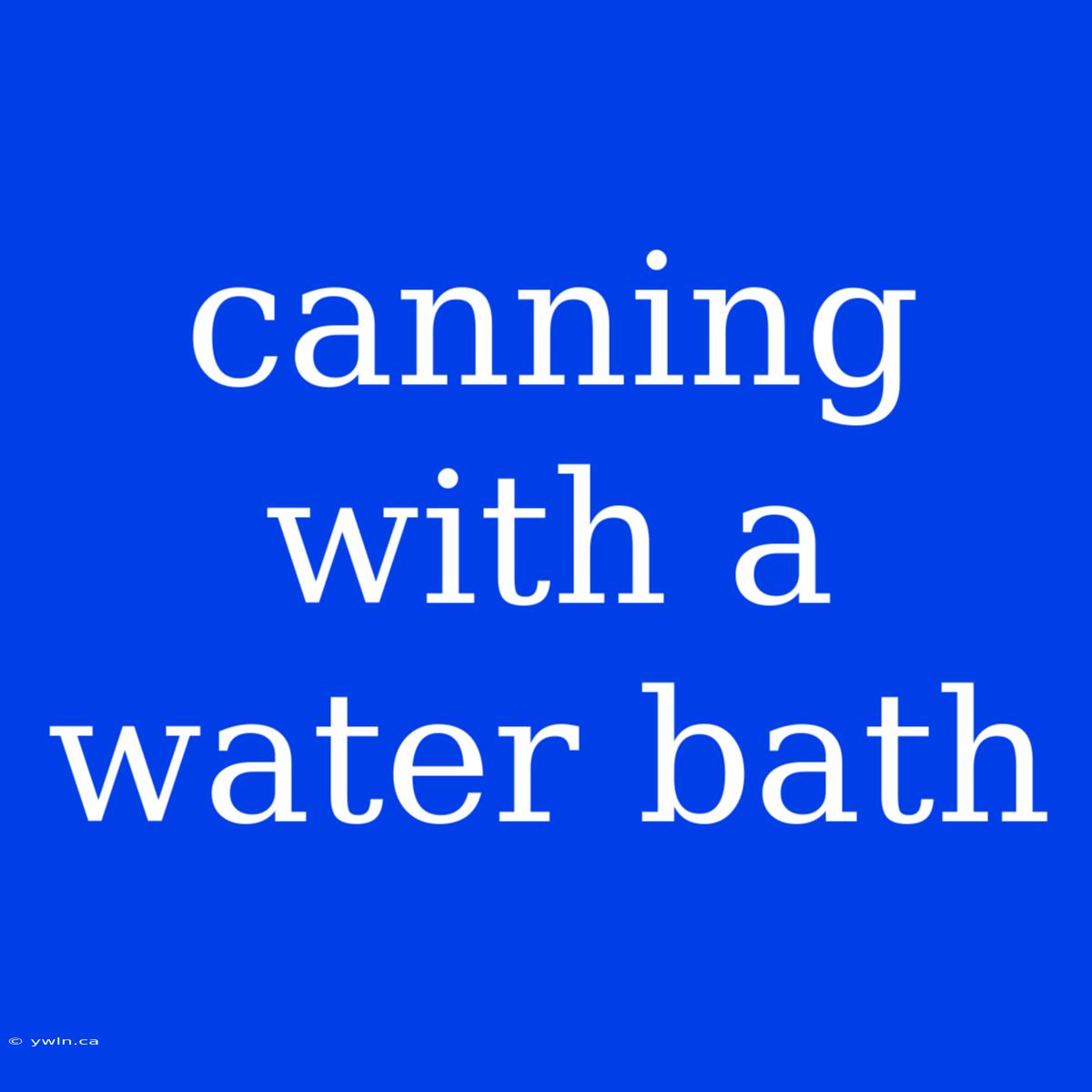Unveiling the Secrets of Water Bath Canning: A Guide to Safe and Delicious Preserving
What is water bath canning, and why should you care? Water bath canning is a simple yet effective method for preserving fruits, vegetables, and some acidic foods like tomatoes. It involves submerging sealed jars in boiling water to create a high-heat environment that destroys harmful bacteria and ensures long-term storage.
Editor Note: This comprehensive guide delves into the world of water bath canning, outlining the key steps, equipment, and safety precautions. Whether you're a seasoned canner or a curious beginner, this article equips you with the knowledge to preserve delicious flavors for months to come.
Analyzing the Water Bath Canning Process: Unveiling the Steps and Safety Measures
To create this guide, we've meticulously researched and analyzed the best practices for successful water bath canning. We've consulted with seasoned canners, delved into reputable sources, and distilled the essential information into a user-friendly format.
Key Insights into Water Bath Canning: A Table for Your Convenience
| Aspect | Description |
|---|---|
| Purpose | Extends shelf life of foods by eliminating bacteria |
| Methods | Water bath (for high-acid foods) & pressure canning (for low-acid foods) |
| Equipment | Canning jars, lids, rings, pot, rack, tongs, jar lifter, thermometer |
| Safety Precautions | Use proper recipes, follow instructions, maintain proper processing times |
| Benefits | Freshness preservation, cost-saving, diverse culinary uses |
Let's Explore the Essential Steps of Water Bath Canning
1. Preparing for the Process:
- Gathering Your Arsenal: Assemble essential canning supplies like jars, lids, rings, a large pot, a canning rack, tongs, a jar lifter, and a thermometer.
- Sterilizing the Jars: Clean jars thoroughly, then sterilize them by boiling for 10 minutes or using a dishwasher on the sanitize cycle.
- Preparing the Lids: Wash the lids in hot, soapy water but do not boil them.
2. Mastering the Recipe:
- Choosing the Right Recipes: Utilize tested and proven recipes designed specifically for water bath canning.
- Following the Instructions: Adhere strictly to the recipe's instructions, ensuring proper ingredients, quantities, and processing times.
3. Filling and Sealing:
- Packing the Jars: Fill sterilized jars with the prepared food, leaving appropriate headspace as specified in the recipe.
- Wiping the Rims: Carefully wipe jar rims with a clean damp cloth to remove any food particles.
- Securing the Lids: Place a lid on each jar and screw the ring on finger-tight.
4. Processing the Jars:
- Boiling Water Bath: Fill a large pot with enough water to cover jars by at least an inch.
- Submerging the Jars: Place jars in a canning rack and carefully lower them into the boiling water, ensuring they are completely submerged.
- Maintaining the Boil: Keep the water at a rolling boil for the time specified in the recipe.
5. Cooling and Storage:
- Cooling the Jars: After processing, carefully remove jars from the pot using a jar lifter and allow them to cool completely.
- Testing the Seals: As jars cool, you'll hear a "popping" sound as the lids seal.
- Storing the Jars: Once cooled, store jars in a cool, dark, and dry place.
The Power of Acid: The Key to Safe Water Bath Canning
Acid's Role in Preservation: Acid acts as a natural preservative, inhibiting the growth of harmful bacteria. For water bath canning, recipes often call for the addition of vinegar, lemon juice, or citric acid to ensure proper acidity levels.
Safety Considerations: Understanding the Importance of Acid
- Low-Acid Foods: Foods like beans, corn, and meat have a naturally low acid content and require a pressure canner to create the high-heat environment needed for safe preservation.
- High-Acid Foods: Foods like fruits, tomatoes, and pickles have a naturally high acid content and can be safely preserved using a water bath canner.
FAQs About Water Bath Canning
Q: Can I use any jars for canning? A: Use only jars specifically designed for canning, as they are made of tempered glass and have a secure lid seal.
Q: What if a jar doesn't seal? A: If a jar doesn't seal, it's not safe to store. You can try re-processing the jar, but if it fails again, it's best to discard it.
Q: How long do water bath canned foods last? A: Properly canned foods can last for one to two years when stored in a cool, dark, and dry place.
Q: Can I reuse canning lids? A: No, lids are single-use and should be discarded after each use.
Tips for Successful Water Bath Canning
- Use fresh, high-quality ingredients.
- Follow recipes diligently, ensuring accurate measurements and processing times.
- Maintain a steady rolling boil throughout the processing time.
- Avoid overfilling jars, leaving the recommended headspace.
- Keep a clean and organized workspace.
A Summary of Your Water Bath Canning Journey
This exploration of water bath canning has illuminated the essential steps, safety measures, and underlying principles of this traditional method of preservation. By mastering the art of water bath canning, you'll unlock the ability to preserve delicious flavors and enjoy the fruits (and vegetables) of your labor for months to come. Embrace the rewarding experience of bringing the bounty of the season into your pantry, one jar at a time.

